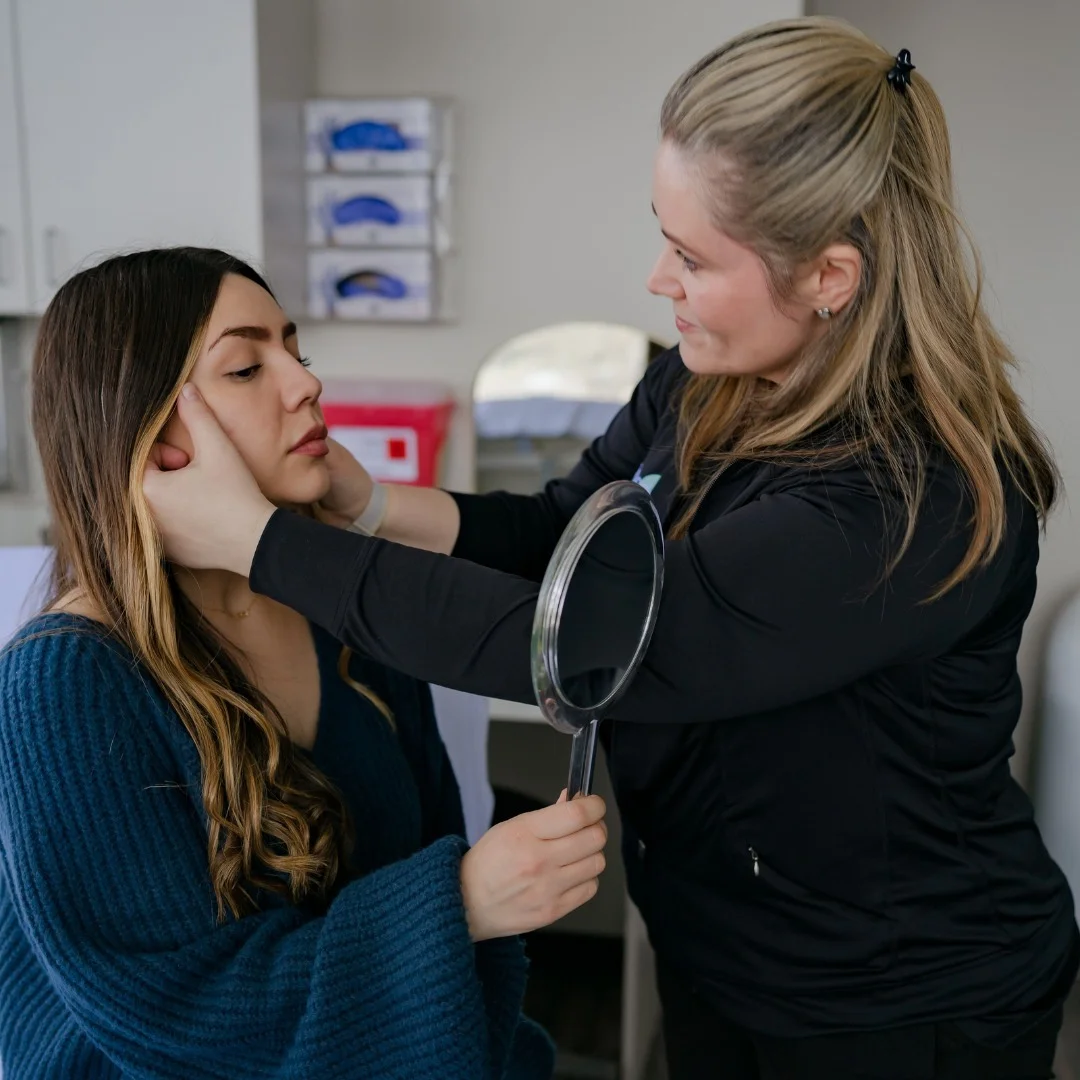Melasma is a common skin condition that affects millions of people, causing brown or grayish-brown patches to appear on the face. While harmless, these patches can be a source of self-consciousness for many who experience them.
At AboutSkin Dermatology and Aesthetics, our Board-Certified Dermatologists understand the frustration melasma can cause and offer advanced, evidence-based approaches to manage this challenging condition. With the right treatment strategy, many patients see significant improvement in their melasma symptoms.
What Is Melasma?
Melasma is a form of hyperpigmentation that appears as irregular brown or grayish-brown patches, primarily on the face. The condition results from overactive melanocytes—the cells that produce melanin, the pigment responsible for skin color. When these cells produce too much melanin, the excess pigment creates the characteristic patches seen in melasma.
Unlike some other forms of hyperpigmentation, melasma patches tend to be larger, with less defined borders and typically appear symmetrically on both sides of the face. The most common locations include the cheeks, forehead, bridge of the nose, upper lip, and chin.
Melasma is more prevalent in women, particularly those with medium to darker skin tones, though it can affect anyone. Approximately 90% of melasma cases occur in women, with only 10% affecting men.
What Causes Melasma?
The exact cause of melasma isn’t fully understood, but several factors contribute to its development. Hormonal changes play a significant role, which explains why the condition is sometimes called the “mask of pregnancy.” Pregnancy, hormonal birth control, hormone replacement therapy, and thyroid disorders can all trigger or worsen melasma.
Ultraviolet (UV) light from the sun is perhaps the most significant trigger. UV exposure stimulates melanocytes to produce more melanin, which is why melasma often worsens in summer and improves in winter. Even brief exposure to sunlight can trigger or worsen melasma in susceptible individuals.
There appears to be a genetic component to melasma as well, as up to 70% of patients report having a family member with the condition. This genetic predisposition makes some individuals more susceptible when exposed to triggers like hormonal changes or UV light.
Additional factors that may contribute to melasma include heat and infrared light, visible light (including blue light from screens), certain medications, skin irritation and inflammation, and stress.
Symptoms and Impact
The primary symptom of melasma is the appearance of brown or grayish-brown patches on the skin. These patches are flat, not raised, and don’t cause physical discomfort like itching or pain. The condition can follow different patterns: centrofacial (affecting the forehead, cheeks, upper lip, nose, and chin), malar (appearing only on the cheeks and nose), or mandibular (occurring along the jawline).
While melasma doesn’t pose any health risks, its visible nature can have significant psychological effects. Many patients report decreased quality of life, reduced self-esteem, and feelings of embarrassment or self-consciousness due to their melasma.
Treatment Options for Melasma
Treating melasma requires a multi-faceted approach, as no single treatment works for everyone. Our Board-Certified Dermatologists at AboutSkin Dermatology and Aesthetics tailor treatment plans to each patient’s specific needs.
Topical Treatments
Prescription topical treatments form the foundation of melasma management. Hydroquinone is a prescription-strength lightening agent that reduces the activity of melanin-producing cells. Due to potential side effects with prolonged use, it is typically used for limited periods. Tretinoin, a vitamin A derivative, increases cell turnover, helping to clear hyperpigmented cells more quickly.
Corticosteroids reduce inflammation that can trigger melasma and are often combined with hydroquinone and tretinoin in formulations known as “triple cream.” Newer options include tranexamic acid, which interferes with the interaction between melanocytes and skin cells to reduce pigmentation, and cysteamine, an antioxidant that inhibits melanin production through multiple mechanisms. Azelaic acid, derived from grains, has anti-inflammatory and pigment-lightening properties.
Professional Procedures
Professional procedures may be recommended for more resistant cases of melasma. Medium-depth chemical peels using glycolic acid, salicylic acid, or trichloroacetic acid can help remove pigmented skin cells and stimulate skin renewal. Microneedling creates tiny punctures in the skin to enhance the delivery of topical treatments and stimulate collagen production.
Certain non-ablative lasers and intense pulsed light treatments can target excess pigment without damaging surrounding tissue. These must be approached cautiously as aggressive laser treatments can sometimes worsen melasma.
Combination Approaches
The most effective melasma treatment plans often combine multiple approaches: topical treatments to address pigmentation, sun protection to prevent triggers, professional procedures to enhance results, and maintenance therapy to prevent recurrence.
Prevention and Management Strategies
Since melasma can be triggered or worsened by various factors, prevention is a crucial part of management. Rigorous sun protection is non-negotiable for melasma patients. This includes using broad-spectrum SPF 30-50 sunscreen daily and reapplying every two hours when outdoors. Physical/mineral sunscreens containing zinc oxide or titanium dioxide are often recommended, along with wearing wide-brimmed hats and sun-protective clothing. Seeking shade, especially between 10 a.m. and 4 p.m., and using visible light protection (tinted sunscreens with iron oxides) are also important.
A gentle skincare routine can help manage melasma. Avoid irritating skincare products that can trigger inflammation, use antioxidant serums to neutralize free radicals, choose gentle cleansers that don’t strip the skin, and consider skincare products with brightening ingredients like vitamin C, niacinamide, or licorice extract.
For patients whose melasma is triggered by hormonal factors, discussing alternative birth control methods with your healthcare provider and considering hormone testing if melasma appears suddenly without other triggers may be beneficial.
When to See a Dermatologist
While mild melasma may respond to over-the-counter treatments, it’s advisable to consult a Board-Certified Dermatologist if your melasma is widespread or severe, over-the-counter treatments haven’t worked, the condition is causing emotional distress, or you’re unsure if your skin condition is melasma or something else.
Professional dermatological care offers several advantages, including accurate diagnosis to confirm melasma and rule out other conditions, access to prescription-strength treatments, personalized treatment plans based on your specific triggers and skin type, expert guidance on combining treatments for optimal results, and monitoring for potential side effects of treatments.
The Importance of Realistic Expectations
It’s important to understand that melasma can be managed but is often challenging to eliminate completely. Treatment success varies based on the duration and severity of melasma, underlying triggers, individual skin type and genetics, and consistency with treatment and prevention.
Many patients see significant improvement with appropriate treatment, but maintenance therapy is typically needed to sustain results. Melasma can recur if triggers like sun exposure or hormonal changes are reintroduced.
Contact AboutSkin Dermatology and Aesthetics for Your Personalized Treatment Plan
At AboutSkin Dermatology and Aesthetics, we understand that melasma can be frustrating and persistent. Our Board-Certified Dermatologists have extensive experience diagnosing and treating this condition with evidence-based approaches.
We create personalized treatment plans based on your specific type of melasma, skin tone, and contributing factors. By combining medical expertise with the latest treatment options, we help our patients achieve clearer, more even-toned skin.
If you’re struggling with melasma, schedule a consultation with one of our Board-Certified Dermatologists to develop a treatment strategy tailored to your needs. Call 303-756-7546 or contact us online today.


